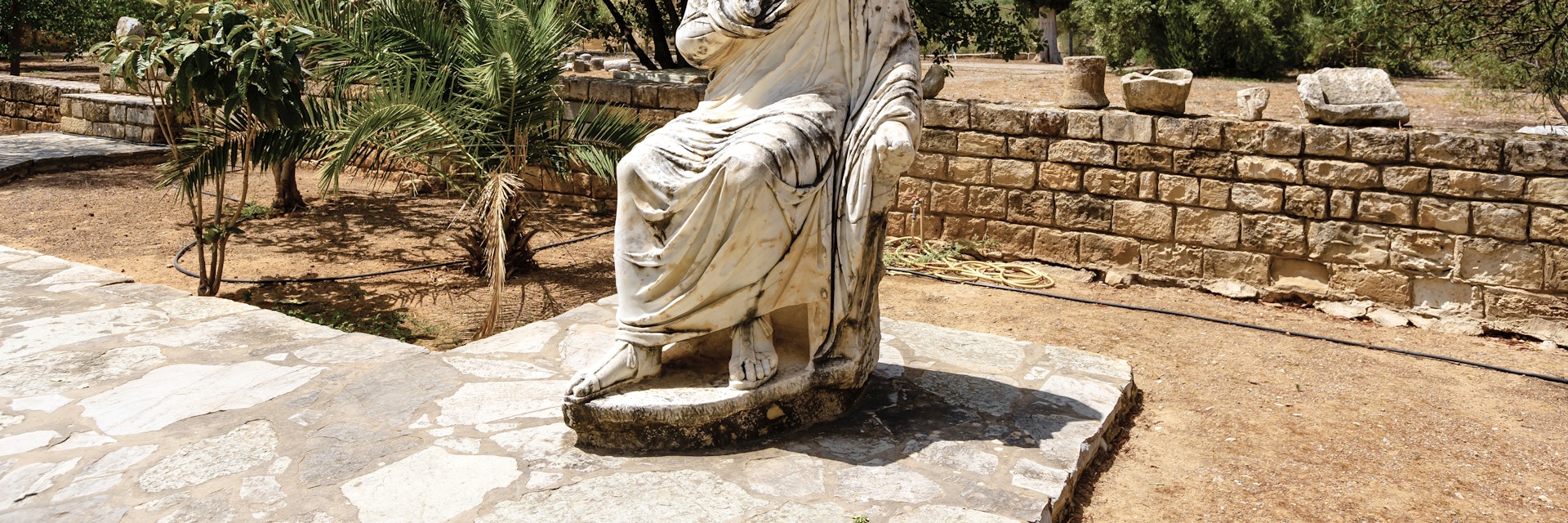Gortyna (also Gortyn or Gortys) has been inhabited since Neolithic times but reached its pinnacle after becoming the capital of Roman Crete from around 67 BC until the Saracens raided the island in AD 824. At its peak, as many as 100,000 people may have milled around Gortyna's streets.
There are two sections, bisected by the highway. Most people only stop long enough to investigate the fenced area on the north side of the road past the entrance. However, several more important temples, baths and other buildings are scattered south of the road.
The first major monument visible within the fenced area is the 6th-century Byzantine Basilica of Agios Titos, the finest early-Christian church in Crete. Probably built atop an even older church, its only major surviving feature is the soaring apse flanked by two side chapels. It reopened after a long-haul restoration in 2019.
A few steps away is the Odeion, a Roman theatre from the 1st century BC, which was levelled by an earthquake and rebuilt by Trajan in the 2nd century AD. The covered, arched structure on the far side of the theatre shelters Gortyna’s star attraction: the massive stone tablets inscribed with the 6th-century-BC Laws of Gortyna. The 600 lines written in a Dorian dialect represent the oldest law code in the Greek world and provide a fascinating insight into the social structure of pre-Roman Crete. It turns out that ancient Cretans were preoccupied with the same issues that drive people into court today – marriage, divorce, property transfers, inheritance and adoption, as well as criminal offences. Behind the Odeion is an evergreen plane tree that, according to mythology, was Zeus and Europa’s ‘love nest’.
Excavations are still in full swing in the area south of the highway and all the sites can only be seen through a chain-link fence. Still, it’s fun to wander aimlessly and just stumble upon the ruins. If you prefer to explore in a more organised fashion, walk 300m east along the highway from the parking lot to a double sign pointing to the Temple of Apollo and the Temple of the Egyptian Gods. A narrow stone path leads to the latter after about 70m. Dedicated to Isis, Serapis and Anubis, there actually isn't much to see today. The same cannot be said of the Temple of Pythian Apollo, reached by continuing on the path past the sign pointing left to the Praetorium, the main sanctuary of pre-Roman Gortyna. It was built in the 7th century BC, expanded in the 3rd century BC and converted into a Christian basilica in the 2nd century AD. You can still make out its rectangular outline and the base of the main altar.
Backtrack and turn right at the sign to shortly reach the Praetorium. The palace of the Roman governor of Crete, it served as an administrative building, a church and a private residence. Most of the ruins date from the 2nd century AD and were repaired in the 4th century. To the north is the 2nd-century Nymphaeum, a public bath supplied by an aqueduct bringing water from Zaros. It was originally adorned with statues of nymphs.
For a bird’s-eye view of Gortyna, climb to the hilltop Acropolis, which also features impressive sections of the pre-Roman ramparts. The trailhead is on the north side of the highway, about 100m west of the entrance; it takes about 20 to 30 minutes to get up here.
Gortyna is near Agia Deka, about 46km southwest of Iraklio. It's a stop on the Iraklio–Matala and Iraklio–Agia Galini bus routes. In Iraklio, buses leave from KTEL Heraklion Lassithi Bus Station.








